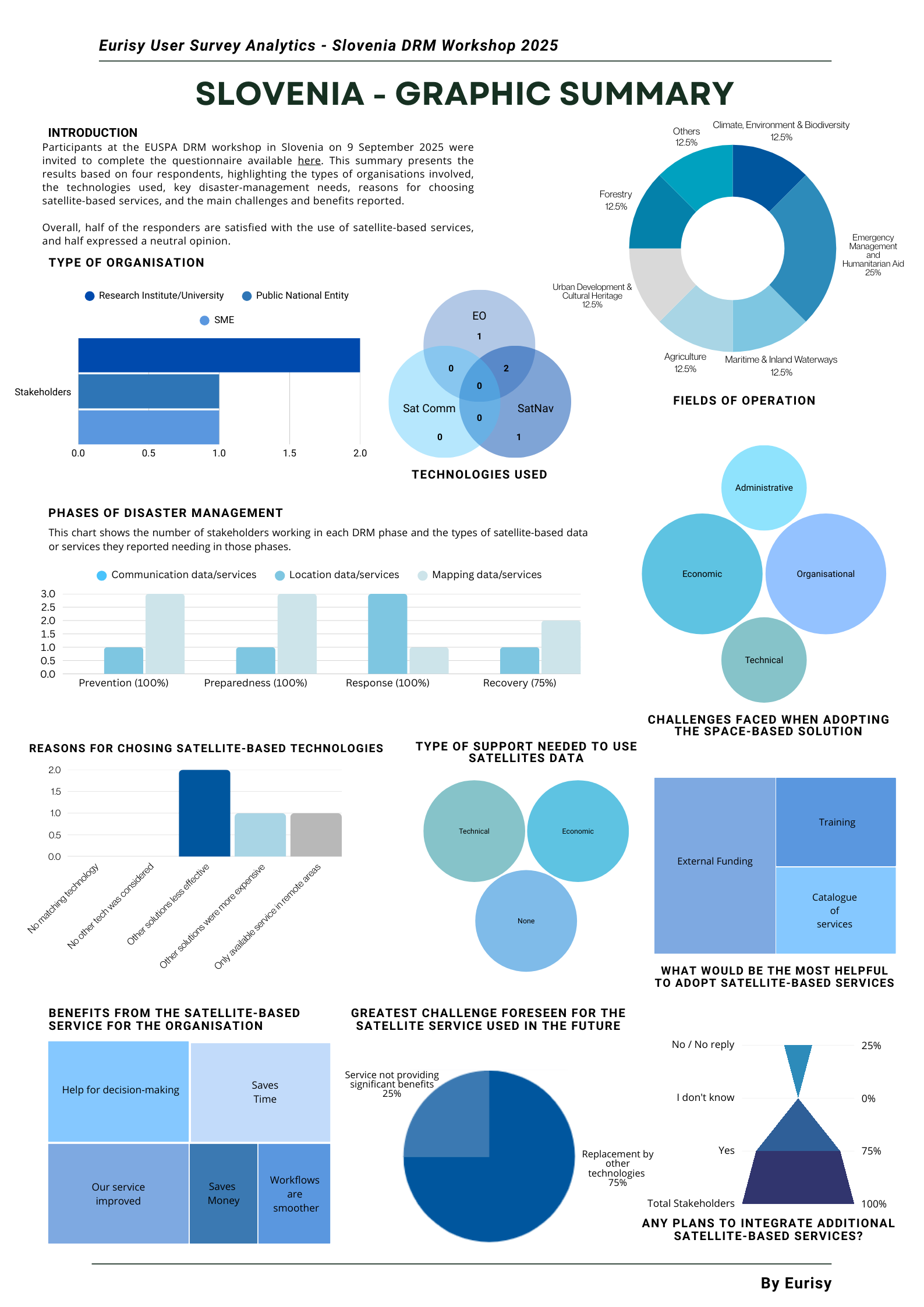Shaping Tomorrow’s Safety: Insights on Disaster Risk from Slovenia
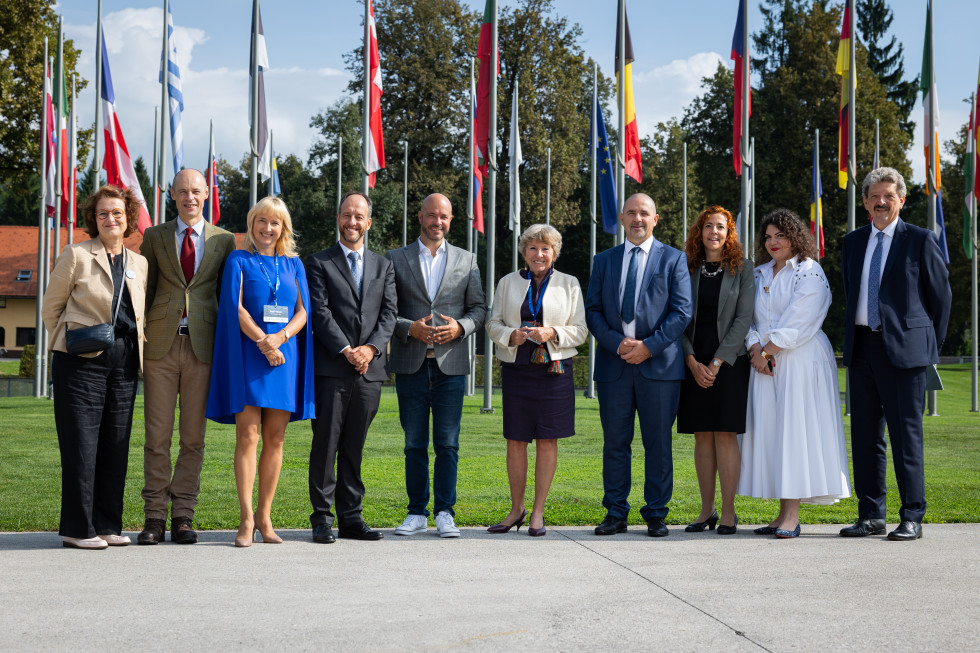
On 9 September 2025, stakeholders from public authorities, research institutions, civil society, and the private sector convened in Kranj, Slovenia to address disaster risk management (DRM) challenges and the use of satellite technologies. The event, co-organised with the Slovenian Space Office, was organised as part of a series of national workshops initiated by the European Union Agency for the Space Programme (EUSPA) and supported by Eurisy to raise awareness on the many possibilities offered by the EU space programmes to support disaster risk management.
Slovenia faces a diverse range of natural hazards, including floods, wildfires and landslides. Between 2012 and 2024, Slovenia activated the Copernicus Emergency Management Service (CEMS) Rapid Mapping capability 16 times, with flooding being the most significant reason. In recent years, the country has experienced several instances of severe flooding due to intense rainfall and overflowing rivers, causing widespread damage to infrastructure and agricultural land.
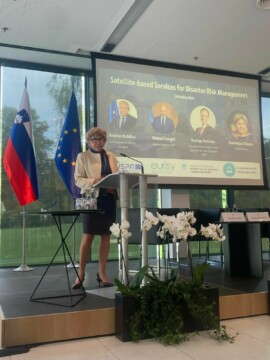
Dominique Tilmans, Eurisy president, giving her introduction speech
The event began with a series of welcoming speeches. Talking about the importance of satellite data in disaster management Matevž Frangež, State Secretary at the Ministry of the Economy, Tourism and Sport, said: “The European space sector is one of the key drivers of growth for Europe and a sector in which Europe still holds a leading position in certain segments. This is also thanks to the successful space program of the European Union, such as the Galileo and Copernicus programs, which are managed by the EU Space Program Agency. This sector is also a driver of economic growth and innovation for Slovenia. In recent years, the Slovenian space sector has shown rapid growth. At the beginning of the year, Slovenia became a full member of the European Space Agency and doubled its funding for development in this area. Slovenia however relies on the European Union’s total capacity for the use of space technologies”. Representing the EU Space Programme, Rodrigo da Costa, Executive Director of EUSPA, said: “The EU space technology is an essential tool in disaster risk management. The EU Space Programme provides critical support for emergency response, helping authorities make faster, data-driven decisions that save lives and protect communities. By leveraging Copernicus, GOVSATCOM and Galileo for precise positioning and emergency alerting, we, together, are strengthening Europe’s resilience against natural and manmade disasters, bringing EU Space closer to citizens.”. Highlighting the need to raise awareness of satellite services, Eurisy president Dominique Tilmans said: “In a crisis, speed and clarity matter: information must be understood, trusted, and acted upon quickly. Effective disaster response means acting early, targeting resources, and protecting lives—and space technologies can make the difference. That’s why Eurisy, with EUSPA, is organising the Satellite-based Services for Disaster Risk Management workshops: to make space solutions accessible and usable. Space technology is a powerful ally for solidarity, cooperation, and national resilience in disaster events.”
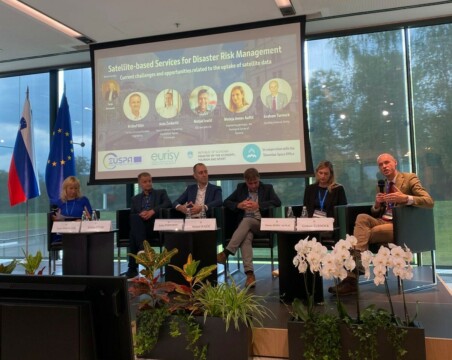
From left to right: Tanja Permozer (Slovenian Space Office), Krištov Oštir (Faculty of Civil and Geodetic Engineering), Anže Žnidaršič (Flycom), Matjaž Ivačič (Geocodis), Mateja Jemec Auflič (Geological Survey of Slovenia) and Graham Turnock (Eurisy)
During the morning, a High level policy panel explored Slovenia’s growing space ecosystem and the collaborative efforts between ministries, agencies, industry, and academia. The discussion focused on operationalising EU satellite services, strengthening disaster risk management, fostering innovation and entrepreneurship, and building the next generation of space experts. The session concluded with an emphasis on awareness, tailored national solutions, and international cooperation to fully leverage space capabilities for societal, economic, and security resilience. Following this, a EU Components panel examined how Copernicus, Galileo and future GOVSATCOM and IRIS² support disaster risk management across prevention, preparedness, response and recovery. EUSPA representatives highlighted the value of open satellite data, emergency mapping and secure communications, alongside opportunities for research and innovation funding through Horizon Europe and CASSINI. Slovenian representatives shared lessons from severe floods in 2023, highlighting both the benefits of these services and the need for faster activation, better coordination, while emphasising the potential value of a planned new national hub for geospatial data to future disaster risk management.
The afternoon panels looked in more detail at user experience with satellite enabled services for DRM. Speakers stressed the importance of trust, integration, and communication across all levels, from local communities to global institutions, and of moving beyond pilot projects to make satellite services become part of systematic resilience strategies. Closing the “last mile” by turning complex data into simple, timely and actionable information for end users was emphasised as crucial.
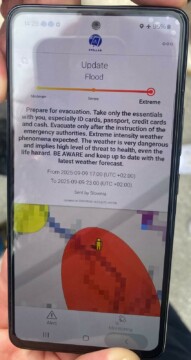
During the afternoon participants also had the opportunity to see a demonstration of the planned new Galileo Emergency Warning Satellite Service (EWSS). This capability, which is in its testing phase, will provide a means of broadcasting real-time alert messages to smartphones via Galileo satellites, including information such as hazard type, severity, timing, area affected and safety instructions. The EWSS will enable transmission of alert messages even when terrestrially based systems are unavailable.
As a whole the workshop served to highlight the critical need for effective DRM, ongoing action to strengthen this within Slovenia, in particular through national coordination on geospatial data, as well recognising the role of satellite services as critical DRM infrastructure. Discussions underlined the importance of strong collaboration among all actors – SMEs, academia, government and others – to ensure effective disaster risk management. Finally, a strong emphasis was placed both on the need to transform existing data into actionable information for decision-makers and on the need to invest in capacity building and in STEAM education to develop the next generation of experts.
EWSS demonstration, showing the following message “Flood, Extreme. Prepare for evacuation. Take only essentials with you, especially ID cards, passport, credit cards and cash. Evacuate only after the instruction of the emergency authorities. Extreme intensity weather phenomena expected. The weather is very dangerous and implies high level of threat to health, even the life hazard. BE AWARE and keep up to date with the latest weather forecast.”
During the workshop, participants were also invited to complete a questionnaire available here on their uses of satellite-based services. You can find the results below:
